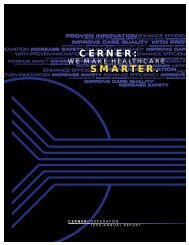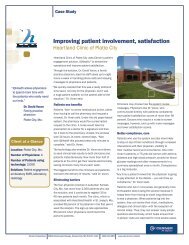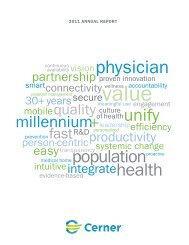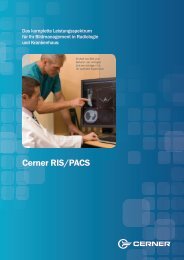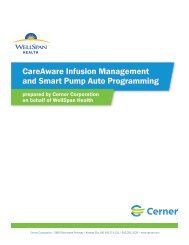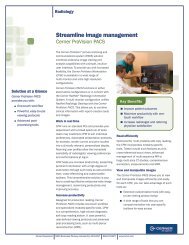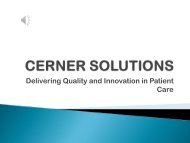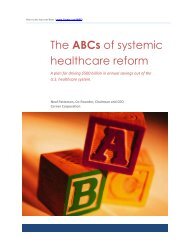The ABCs of systemic healthcare reform - Cerner Corporation
The ABCs of systemic healthcare reform - Cerner Corporation
The ABCs of systemic healthcare reform - Cerner Corporation
- No tags were found...
Create successful ePaper yourself
Turn your PDF publications into a flip-book with our unique Google optimized e-Paper software.
A key point regarding our margin expansion strategy is that we are executing it while our business model is transitioning to more<br />
visible and recurring revenue components. For example, in 2000, approximately 55% <strong>of</strong> <strong>Cerner</strong>’s revenue (before reimbursed<br />
travel) came from what we consider visible or recurring sources such as Pr<strong>of</strong>essional Services, Managed Services, Subscriptions/<br />
Transactions and Support & Maintenance. In 2008, 74% <strong>of</strong> our revenue came from these sources.<br />
Earnings Growth<br />
With 10% top-line growth and strong margin expansion, we grew our earnings 26% in 2008. Our 3, 5 and 10-year compound<br />
annual earnings growth rates <strong>of</strong> 29%, 34% and 23%, respectively, reflect our ability to drive long-term earnings growth. Going<br />
forward, our top-line strategies coupled with continued focus on productivity enhancements and margin expansion position us<br />
well for continued good earnings growth.<br />
Generating Cash Flow<br />
A healthy business generates cash flow. Perhaps our most significant improvement over the past few years has been in our cash<br />
flow performance. 2008 was a record year <strong>of</strong> cash performance with $282 million <strong>of</strong> operating cash flow and $104 million <strong>of</strong> free<br />
cash flow (operating cash flow less capital expenditures and capitalized s<strong>of</strong>tware). <strong>The</strong> $104 million <strong>of</strong> free cash flow represents<br />
a substantial improvement from the 2007 level <strong>of</strong> $28 million as capital expenditures decreased from 2007 levels due to the<br />
completion <strong>of</strong> a <strong>Cerner</strong>Works data center facility and decreased spending on other <strong>of</strong>fice facilities. Capital expenditures in 2009<br />
are expected to increase over 2008 levels, but we are still expecting strong free cash flow.<br />
Stock Price<br />
At <strong>Cerner</strong>, we manage the company, not the stock price. In the short term, the stock price can be influenced by many factors beyond<br />
our control, but we believe in the long term it will closely reflect the quality <strong>of</strong> our decisions. We believe it is important for our<br />
shareholders that we focus on delivering strong long-term results,<br />
but we also understand the importance <strong>of</strong> delivering consistently<br />
against short-term targets.<br />
<strong>The</strong> weak broader economy impacted almost all companies and<br />
stocks in 2008, with the NASDAQ Composite Index and S&P 500<br />
declining 41% and 38%, respectively. And despite solid financial<br />
results, <strong>Cerner</strong>’s stock price finished the year down 32%, which<br />
is better than the broader market but still disappointing. When<br />
measuring <strong>Cerner</strong>’s stock performance over the 5-, 10- and<br />
20-year periods using compound annual growth rates, the<br />
returns are 15%, 11% and 20%, respectively. <strong>The</strong>se returns are<br />
significantly greater than the returns over the same time frames<br />
for the NASDAQ Composite Index (-5%, -3% and 7%) and S&P 500<br />
(-4%, -3% and 6%).<br />
$300<br />
$250<br />
$200<br />
$150<br />
$100<br />
$50<br />
$-<br />
Operating Cash Flow<br />
Free Cash Flow<br />
‘00 ‘01 ‘02 ‘03 ‘04 ‘05 ‘06 ‘07 ‘08<br />
$(50)<br />
*FCF = Operating CF less Capital Expenditures and Capitalized S<strong>of</strong>tware<br />
18



